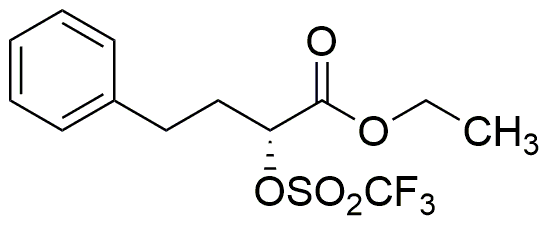Ethyl (R)-4-Phenyl-2-(trifluoromethanesulfonyloxy)butyrate is widely utilized in research focused on:
- Synthesis of Pharmaceuticals: This compound serves as an important intermediate in the synthesis of various pharmaceuticals, particularly in the development of anti-inflammatory and analgesic drugs, enhancing their efficacy and reducing side effects.
- Organic Synthesis: It is used in organic chemistry for the preparation of complex molecules, allowing researchers to explore new chemical reactions and pathways, which can lead to innovative materials and compounds.
- Fluorinated Compounds Production: The trifluoromethanesulfonyloxy group provides unique properties that are beneficial in creating fluorinated compounds, which are crucial in agrochemicals and specialty chemicals, improving their stability and performance.
- Biochemical Research: This chemical is employed in biochemical studies to modify proteins or other biomolecules, facilitating the understanding of biological processes and the development of targeted therapies.
- Material Science: It finds applications in the development of advanced materials, such as polymers and coatings, where its unique properties can enhance durability and resistance to environmental factors.
General Information
Properties
Safety and Regulations
Applications
Ethyl (R)-4-Phenyl-2-(trifluoromethanesulfonyloxy)butyrate is widely utilized in research focused on:
- Synthesis of Pharmaceuticals: This compound serves as an important intermediate in the synthesis of various pharmaceuticals, particularly in the development of anti-inflammatory and analgesic drugs, enhancing their efficacy and reducing side effects.
- Organic Synthesis: It is used in organic chemistry for the preparation of complex molecules, allowing researchers to explore new chemical reactions and pathways, which can lead to innovative materials and compounds.
- Fluorinated Compounds Production: The trifluoromethanesulfonyloxy group provides unique properties that are beneficial in creating fluorinated compounds, which are crucial in agrochemicals and specialty chemicals, improving their stability and performance.
- Biochemical Research: This chemical is employed in biochemical studies to modify proteins or other biomolecules, facilitating the understanding of biological processes and the development of targeted therapies.
- Material Science: It finds applications in the development of advanced materials, such as polymers and coatings, where its unique properties can enhance durability and resistance to environmental factors.
Documents
Safety Data Sheets (SDS)
The SDS provides comprehensive safety information on handling, storage, and disposal of the product.
Product Specification (PS)
The PS provides a comprehensive breakdown of the product’s properties, including chemical composition, physical state, purity, and storage requirements. It also details acceptable quality ranges and the product's intended applications.
Certificates of Analysis (COA)
Search for Certificates of Analysis (COA) by entering the products Lot Number. Lot and Batch Numbers can be found on a product’s label following the words ‘Lot’ or ‘Batch’.
*Catalog Number
*Lot Number
Certificates Of Origin (COO)
This COO confirms the country where the product was manufactured, and also details the materials and components used in it and whether it is derived from natural, synthetic, or other specific sources. This certificate may be required for customs, trade, and regulatory compliance.
*Catalog Number
*Lot Number
Safety Data Sheets (SDS)
The SDS provides comprehensive safety information on handling, storage, and disposal of the product.
DownloadProduct Specification (PS)
The PS provides a comprehensive breakdown of the product’s properties, including chemical composition, physical state, purity, and storage requirements. It also details acceptable quality ranges and the product's intended applications.
DownloadCertificates of Analysis (COA)
Search for Certificates of Analysis (COA) by entering the products Lot Number. Lot and Batch Numbers can be found on a product’s label following the words ‘Lot’ or ‘Batch’.
*Catalog Number
*Lot Number
Certificates Of Origin (COO)
This COO confirms the country where the product was manufactured, and also details the materials and components used in it and whether it is derived from natural, synthetic, or other specific sources. This certificate may be required for customs, trade, and regulatory compliance.

